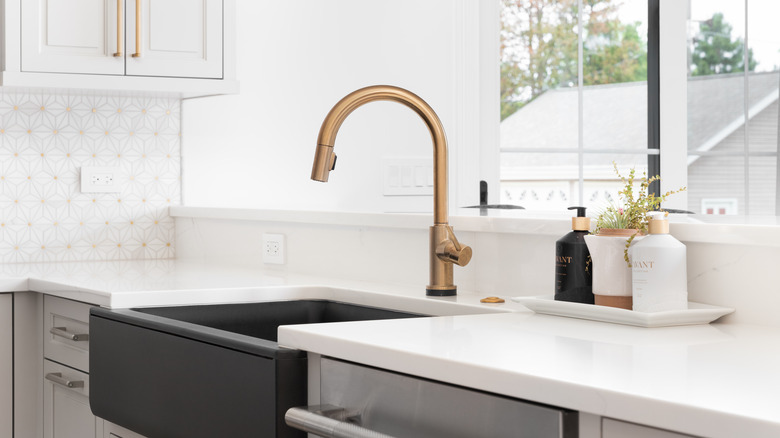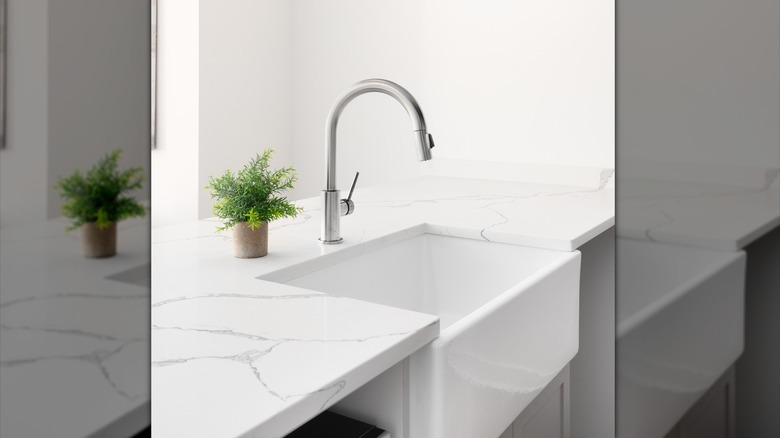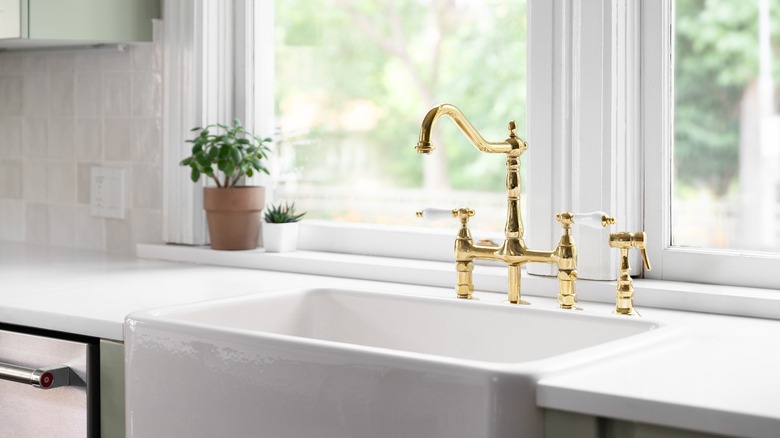Consider Your Kitchen Cabinetry When Choosing Between A Farmhouse Or Apron Sink
Cupboards and cabinets, sofas and couches, side tables and end tables — different words are often used interchangeably to refer to the same thing in the world of interior design. Sometimes it's all semantics, but in other instances there actually are slight differences between the objects people are referring to that matter when it comes to using them. For example, let's look at apron sinks and farmhouse sinks — two types of sinks that seem indistinguishable.
Shopping around, design enthusiasts will find that outlets use both words when naming these kitchen features. Technically speaking, though, there are a couple of small details that differentiate an apron from a farmhouse sink. When diving into the nitty gritty, an apron sink tends to protrude over lower cabinets whereas a farmhouse sink often doesn't. While it's not the end of the world if you call one the other's name, it's helpful to know these discerning details when it comes to properly fitting the sink and ensuring it works with your cabinetry.
What is the difference between a farmhouse sink and an apron sink?
Amid the popularity of modern farmhouse style and smaller niche trends such as the modern prairie aesthetic, apron and farmhouse sinks have been front and center. Stylistically, they make the most sense for exuding farmhouse charm whether they're placed in a kitchen, mudroom, or laundry room. So what makes these two different from one another? It comes down to how much the sink protrudes and the material it's made of which typically denotes one sink over the other.
The biggest difference between the two is, traditionally, the front of an apron sink juts out from the cabinetry it's held in. A farmhouse sink is usually made to sit flush with cabinets. This is a big factor to consider as a farmhouse won't work with all lower cabinet types. In many cases, you'll have to insert extra foundational materials and cut into the tops of doors to make them fit and support the weight of the sink.
Materials vary sometimes, too. A farmhouse sink is usually found in fireclay, stainless steel, and porcelain, whereas apron sinks are normally made of porcelain. That said, nowadays it's easy to find both sinks available in all of these materials. This makes it tricky to truly tell the difference. Apron sinks and farmhouse sinks have a few different configurations, but most share the same unique look, sitting within a countertop towards the very front, allowing the front surface to be exposed.
How to make farmhouse and apron sinks work in your kitchen
There are some things to know before splurging on a farmhouse sink or an apron sink. Even with an awareness of the aforementioned differences, after a little shopping around online, you'll come across some apron sinks that protrude out but are labeled as farmhouse sinks. This can be confusing, so it's important to measure twice and understand how the sink will fit into your existing cabinetry, regardless of its name.
Many other styles of sinks fit directly inside of a countertop with no exposed parts other than the basin. With these two types, you may find some configurations that show more than just the front. Some sinks will be installed to have a top ledge that juts out above the countertop, too. This can be a fun style choice that really highlights your sink. If you're someone who appreciates the ability to sweep crumbs and spills directly into your sink, farmhouse and apron types can be fitted beneath the countertop as well. All in all, it's good to understand how the sink you're eyeing will fit into your cabinetry and how it works into the flow of your kitchen.



